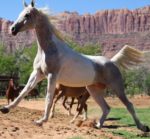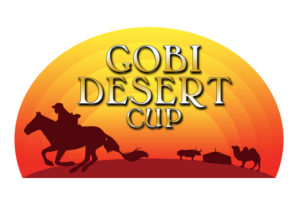“Do you know that your martingales are only on one side?”
On many endurance events, observant and well meaning crew, fellow riders and spectators remind the riders of Global Endurance Center of the fact that their running martingales are on one side of the reins.
Indeed, they are!
Nice symmetrical martingales, but is this arrangement always practical?
What are the reasons for this symmetry? Is it for looks or function?
Riding with symmetrical martingales certainly has it’s place in the arena. But it does not give us any advantages on the trail, on endurance or conditioning rides.
When flexing and bending a horse, symmetrical martingales only allow a flexing of about 45 degrees on each side. After that angle is reached, the opposing martingale will inhibit any further bending by counteracting and preventing the outside of the neck to stretch any further. Just imagine, if you had a difficult horse, a run away or bolt. It would be very hard to bend or circle the horse enough to gain control.
Quite different is the situation with the one sided or asymmetrical martingales.
Now the rider can bend the horse equally and unrestricted on both sides.
One might wonder why we use martingales in the first place.
Martingales have been used in dressage and many other equestrian disciplines to encourage collection and also preventing sudden head tossing by the horses in training or when getting spooked.
Unrestricted bending laterally
Flexing at the poll
When using martingales, it is important to follow these two rules:
-Always use rein stoppers.
-The length of the martingale need to be the proper length: in line with the straight reins from the bit through the hand and elbow of the rider.
If used without rein stoppers, the metal rings can easily catch on the rings of the rein clips, thus creating havoc for the horse and possibly flipping the horse backwards.
Martingales that are too long do not serve any purpose. If they are too short, the reins will get bend downwards, impeding the communication between the horse’s mouth (bit) and the rider. Furthermore, it can over-flex the poll, hindering proper breathing and compromising performance.
Here, the martingale is too short, causing a kink in the reins, thus interrupting the direct line of communication. Hands, elbow and shoulders are in great position otherwise.
Straight line from bit through hands, elbow and shoulders (there can be a small bend at the elbow, depending on the situation)
Nice hand and elbow position on this rider
During endurance rides, you may want to switch the sides of the running martingale. Half of the riding time, place both rings on the left side, the other half on the right side.
If you want to condition one side of the horse more than the other, then select the side accordingly. Let’s say that you train a horse that is left side dominant but you want to strengthen and build up the right side. Placing the rings of the martingale on the left side of the reins will make it easier to shorten that side, lengthen the right side of the neck and shoulder and encourages the horse to take the right lead.
At Global Endurance Training Center we found the use of running martingale very beneficial for most horses, especially during training and conditioning rides. Applied and used properly, it is a very useful tool.
Christoph Schork
from GETC


